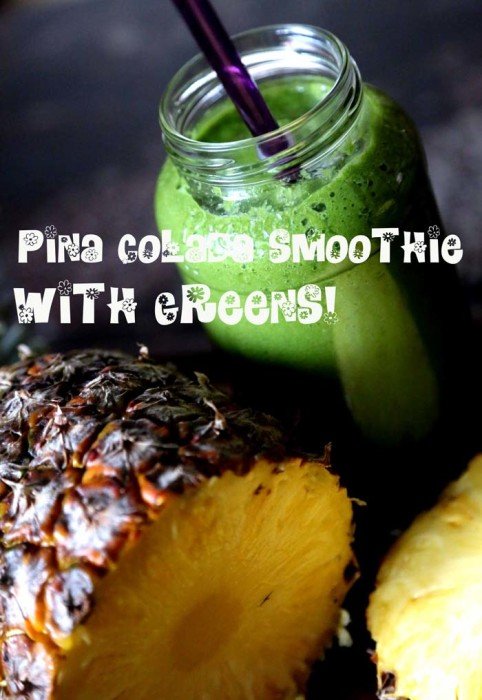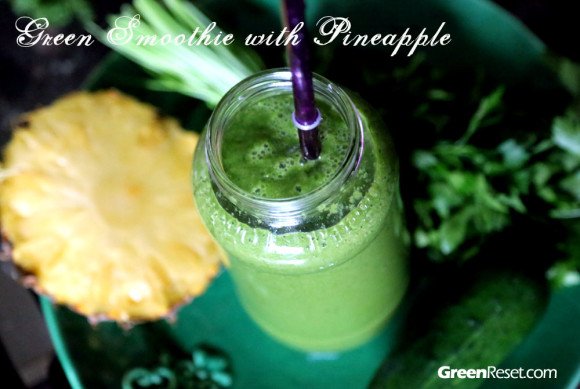When someone is eating a healthy diet, high in fresh fruits, vegetables, greens, legumes, whole grains, nuts and seeds, and low in harmful substances – do they still need to take multivitamins?
I always stress the importance of a whole foods plant-based diet and urge everyone to get their nutrients directly from the source: plants. Just as people are trying to find an easy solution for wellness through pharmaceuticals, many are also replacing proper eating with vitamin and mineral supplements.
But does eating a healthful diet based on whole plant foods offer sufficient protection against chronic disease and excessive weight gain?
According to many experts, there are some nutrients that are lacking even in an ideal diet, and deficiencies can undermine your health. Also, we cannot be really sure that we are getting the precise optimal amounts of vitamins and minerals every day from our diet – especially since absorption efficiency and utilization of nutrients varies from person to person.
So, a high quality supplement can fill these gaps, ensuring that we get adequate amounts of essential micronutrients.
If I drink green smoothies and eat a healthy diet, do I still need a multivitamin?
The best way to find out whether or not you have any nutritional deficiency is by getting tested.
The following vitamins and minerals are often lacking even in a healthy diet and need to be supplemented:
- Vitamin B12
- Vitamin D
- Vitamin K2
- Iodine
- Zinc
Vitamin B12
Vitamin B12 is required for important biological functions like red blood cell production, nervous system function, and DNA synthesis. Deficiency in B12 can cause a variety of health problems including elevated homocysteine (a cardiovascular risk factor), anemia, depression, confusion, fatigue, digestive issues, and nerve damage. Insufficient B12 levels are also associated with increased risk of Alzheimer’s disease.
Vitamin B12 is unique in that it is made only by microorganisms. Because our produce is washed and often transported far before we eat it (soil contains B12-producing microorganisms), most of us are unable to get sufficient B12 from plant foods alone. Some foods (seaweed, mushrooms, tempeh, miso, tamari, and spirulina) have been marketed as good sources of B12, but this was based largely on faulty testing methods. Though they may contain some amounts of B12, many experts contend that these levels are not consistent enough for people to rely on these foods as the sole source of B12 in their diet.
B12 deficiency is common, especially in vegans who don’t supplement and in the elderly – our ability to absorb B12 decreases with age, and about 20% of adults over the age of 60 are either insufficient or deficient in vitamin B12. Supplementation with vitamin B12 is likely important for most people, and absolutely required for most vegans to achieve sufficient B12 levels.
Vitamin D
The best source of vitamin D is the sun, but many people spend most of their time indoors or wear sunscreen, which blocks the absorption of vitamin D. People living in northern climates – or in states with long, cloudy winters – miss out on this “sunshine vitamin.” Also, although most light-skinned people can make enough vitamin D exposing the face and arms each day with five to fifteen minutes of warm sunshine, people with darker skin need at least a half-hour.
Insufficient vitamin D levels are very common. Low levels of vitamin D levels are associated with several cancers, diabetes, cardiovascular disease, depression, and autoimmune diseases. Supplementing is often the best choice for achieving adequate vitamin D levels. Supplementing with at least 1000 IU or even 2000 IU – if you are deficient – you may want to get a blood test to confirm adequate levels.
Vitamin K2
There are two forms of vitamin K, K1 and K2. Vitamin K2 seems to be more important to supplement – vitamin K1 is abundant in leafy green vegetables; vitamin K2 is produced by microorganisms and is low in plant foods. Vitamin K2 supplementation has been shown to reduce the risk of fracture, reduce bone loss, and increase bone mineral density in women with osteoporosis. In several studies, vitamin K2 intake was associated with reduced risk of heart disease or coronary artery calcification (an indicator of increased cardiovascular risk). The human body can synthesize some K2 from K1, and intestinal bacteria can produce some usable K2, but these are very small amounts. Therefore, it is likely important to supplement with K2.
Iodine
Iodine is required by the body to make thyroid hormones. Most plant foods are low in iodine due to soil depletion. Kelp, a sea vegetable, is a good source of iodine, but is not commonly eaten on a regular basis and may actually provide excessive amounts of iodine. The chief source of iodine in the typical American diet is iodized salt. Since salt should be avoided for good health, it is important to supplement with iodine to maintain adequacy.
Zinc
Zinc is essential for immune function, growth, and reproduction, and supports hundreds of chemical reactions. Zinc is abundant whole plant foods, but is not readily absorbed. Beans, whole grains, nuts, and seeds contain zinc, but also contain substances that inhibit zinc absorption. Zinc is especially important for men, because it is concentrated in the prostate and promotes death of cancer cells, possibly by suppressing the activity of inflammatory molecules. Long-term zinc supplementation is associated with reduced risk of advanced prostate cancer.
Calcium
Calcium is a vital nutrient for bone health, muscle contraction, nerve transmission, blood clotting and much more. Calcium requirements vary by age. For adults it’s about 1000 mg. Getting enough calcium should not be a problem for anyone eating a healthy diet, rich in leafy greens, beans, nuts, as well as calcium fortified foods. Although dairy is usually considered the best source of this nutrient, there are many problems with this food group. Read more about calcium rich foods.
Iron
There are some variations for babies, toddlers, and seniors, but the daily recommendation for the U.S. and Canada is 8 milligrams for adult men; 18 milligrams for adult menstruating women, and 27 milligrams for pregnant women; 9 for lactating women (since they’re not menstruating); and 8 for postmenopausal women over 50. None of these groups should exceed 45 milligrams a day, as too much iron can cause an overload.
I get a significant amount of my iron from leafy greens such as parsley, kale and dandelion as well as through other sources in my diet throughout the day. I don’t rely solely on green smoothies for iron, however. Other iron-rich foods include iron-fortified cereals, beans, whole grains (oatmeal, quinoa), seeds (pumpkin) and dried fruits (apricots).
Generally, iron supplements should be avoided (see below). The appropriate times to supplement with iron, are when there is a deficiency or an increased biological need, such as in pregnancy.
Multivitamins must be chosen wisely
Though supplements may be essential when there is a true deficiency or need, they can be unnecessary or even detrimental when we use them as a substitute for a healthful diet. While most people can certainly benefit from a multivitamin, it is important to choose the right one. Some common ingredients in multivitamins may be harmful in isolated supplement form.
The following ingredients should be avoided:
- Vitamin A
- Beta-carotene
- Vitamin E
- Selenium
- Copper
- Folic acid
The synthetic folic acid in supplements is not the same as natural folate, found in high concentrations in green vegetables. If you are drinking green smoothies and/or eating your leafy green vegetables, you should be getting enough of this nutrient. Taking supplemental folic acid may increase the risk of breast, prostate, and colorectal cancers. Vitamin A and beta-carotene in supplement form have also been shown to increase the risk of cancers, possibly by interfering with the absorption of other carotenoids, and supplemental vitamin A, beta-carotene, or vitamin E are all associated with increased risk of death. These shocking scientific findings mean that most conventional multivitamins act as a double-edged sword, containing both helpful and harmful elements.
Excess iron may build up and become toxic. The most common culprits of iron and copper excess are red meat and multivitamins. The human body evolved to store excess iron and copper to fuel these reactions in case of extreme conditions like bleeding or famine. However, their accumulation over time may be detrimental because both metals are involved in generating oxidative stress, a byproduct of energy production, which contributes to chronic diseases — specifically cardiovascular disease and brain disorders like Alzheimer’s disease.
Resources:
http://www.drfuhrman.com/library/healthydiet_multi.aspx
http://www.drfuhrman.com/library/mulitvitamins-ingredients-to-avoid.aspx
http://www.compassionatecook.com/writings/podcast-media/the-safety-of-supplements-2
Questions? Comments? Suggestions?
If you have a favorite recipe, why not submit it here in the comment section of this smoothie recipes blog for others to enjoy too!
I also welcome any comments, questions and suggestions. Thanks!
Question: “Joanna, It has been 2 weeks since I have been on the green smoothie diet and feeling good, but being vegetarian I am worried about the protein intake. Do you have any ideas what I should add for protein and how much is good to reduce weight. Thanks”
This question often comes up in the context of plant-strong diet – as so many people are concerned about getting enough protein from plant foods, while also wanting to lose weight.
How much protein do you need?
We only need about 10% of calories coming from protein.
That’s it. Some experts recommend even less than that.
Meanwhile, an average person on a Standard American Diet consumes more like 20% of calories from protein (mostly coming from animals), which is a recipe for a disaster – such as kidney failure, kidney stones, heart diseases, diabetes, cancer, and other.
To calculate the amount of protein that you need, you may use this formula: (the amount of calories you need per day x 0.10)/4 = grams of protein per day.
Example:
For a 140lb female, calorie intake=1800 calories, protein=10%:
1800 x .10 = 180 calories from protein. Since 1 gram of protein = 4 calories, divide protein calories by four:
180/4 = 45 grams of protein per day.
Most people need only about 40-60 grams of protein per day.
Top food sources of healthy protein
Americans seem to be in constant search for protein sources.
What I feel is important to understand is that when you are eating enough calories from a variety of plant sources, such as leafy greens, vegetables, legumes, mushrooms, nuts, seeds, and whole grains, you will be supplying your body with sufficient protein to stay healthy.
Below I list some of the best sources of protein – I mean really, truly lean, mean, cholesterol-free (zero!), fiber- rich, antioxidant-rich, disease-busting, health promoting protein.
Again, what I want to stress is that you don’t need to spend your day with a calculator worrying about getting enough protein into your body. If you are eating a variety of these foods, you will be getting enough.
Keep in mind that all these foods are very low in calories, so in order to meet the caloric requirements, you can actually eat more of these foods, while staying healthy and slim.
1. Leafy greens and vegetables – the proper foundation for all diets. They provide the highest nutrient and protein amount per calorie.
1 cup raw spinach (7 calories) – 1 gram (57% calories from protein!)
1 cup raw kale (33 calories) – 2 grams (24% calories from protein)
1 cup raw broccoli (30 calories) – 3 grams (40% calories from protein)
1 cup cooked broccoli (52 calories) – 4 grams (30% calories from protein)
1 cup cooked spinach (41 calories) – 5 grams (49% calories from protein)
1 cup cooked sweet potato (180) – 5 grams (11% calories from protein)
2. Legumes, specifically lentils and beans, are a rich source of protein, while also high in fiber and zero cholesterol. They’ve constituted the foundation of many diets around the world for centuries.
1 cup soybeans – 28 grams (1 cup tofu – 22 grams, 1 cup tempeh – 30 grams)
1 cup lentils – 18 grams
1 cup boiled split peas – 16 grams
1 cup refried beans – 15.5 grams
1 cup chickpeas (garbanzo beans) and hummus – 15 grams
1 cup pinto, kidney, black beans – 13-15 grams
1 oz peanuts – 6.5 grams
3. Mushrooms
Mushrooms are a good source of protein. Since they are very low in calories, they are some of the highest sources of protein per calorie.
1 cup white mushrooms, stir-fried (28 calories) – 4 grams (57%)
1 cup portabella, grilled (42 calories) – 5 grams (48% calories from protein)
1 cup oyster mushroom (37 calories) – 3 grams (32% calories from protein)
1 cup shitake, stir-fried (43 calories) – 3 grams (28% calories from protein)
4. Nuts and seeds provide proteins too, but should be eaten in moderation if you are trying to lose weight, as they are quite high in calories and fat.
1 ounce cashews – 4.4 grams
1 ounce sesame seeds 6.5 grams, 3 tablespoons of tahini – 8 grams
1/4 cup (2 oz.) walnuts – 5 grams
1 oz. pistachios – 5.8 grams
2 tbsp almonds – 4 grams
Nut butters – peanut butter, almond butter, cashew butter – 2 tablespoons has about 8 grams of protein
5. Grains
Despite what Paleo diet proponents would like us to believe, people have been eating grains for millions of years – and there is more and more scientific research that proves that even in the Paleolithic era they had been using tools to process those grains into flour. Amaranth, bulgur, brown rice, wheat germ, oat bran and other grains are all good sources of protein. Even a bagel has protein, although it is high in calories too.
1 cup oatmeal – 11 grams
1 cup quinoa – 9 grams
1 bagel – 9 grams
Sprouted grain bread products – buns, tortillas, bread. 7-10 grams from the bread alone.
6. Non-dairy milk – Soy, almond, oat. 1 cup gets you 7-9 grams of protein.
7. Convenience foods and supplements: There are plant-based protein powders and bars to fill in the gaps on the go. Hemp – 30 grams of hemp powder in your smoothie gives you 11 grams of protein. Spirulina and chlorella provide rich nutrient content, and protein content.
8. Fruits. Generally, fruits are low in protein, with some exceptions, such as avocado. One large avocado will provide up to 5 grams of protein.

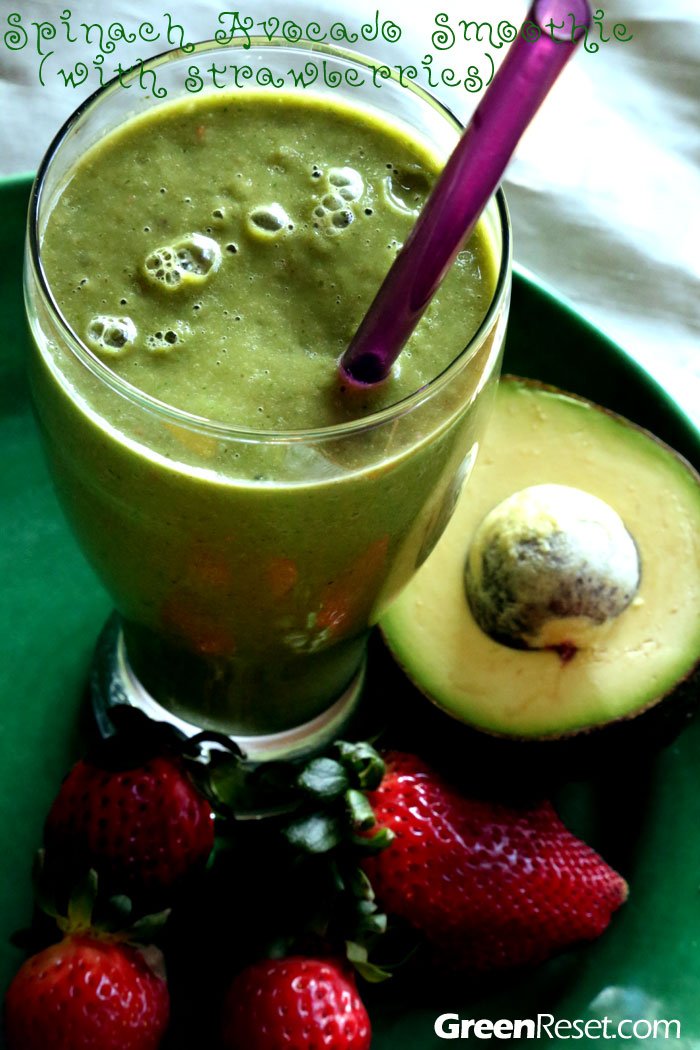
How to make your smoothies rich in protein?
Since fruits are low in protein, if you are concerned about protein, make sure you load up your smoothie with greens.
To further increase the protein content of your smoothie, add a handful of nuts or seeds, such as pumpkin or sunflower seeds. Adding ground nuts or seeds to your smoothie not only adds protein, but boosts the healthy fat content which makes a green smoothie more satisfying and keeps you full longer. Nuts and seeds are also mineral powerhouses and will make your smoothie not only high in vitamins and antioxidants, but also rich with minerals.
Try small amounts of raw nuts such as almonds, cashews, walnuts, Brazil nuts or macadamia nuts. Sunflower, pumpkin, sesame, hemp, flax and chia seeds are all excellent when ground up and added to smoothies. You can also add a tablespoon of raw nut butter, or substitute water with almond milk.
Other ingredients you may add is non-dairy milk, a cup of whole grains (such as oats or quinoa), or legumes (a chunk of tofu).
Just don’t overdo the fat content of your smoothie or else bloating, gas and digestion problems may result.
What to eat besides smoothies?
Prepare main dishes or sides using beans and legumes, mushrooms, vegetables and whole grains. Beans and legumes offer a flavorful, inexpensive, low-fat, healthy protein source.
Snack on nuts and seeds with foods like trail mix, sunflower seeds and shelled nuts. Nuts, seeds and nut butters provide protein in a form that makes a quick snack on-the-go. Don’t discount nuts and seeds as an added dose of protein in your main meals, though. Nuts and seeds make tasty additions to salads and Asian noodle dishes, for example.
Add soy to your favorite dishes. Soy contains as much complete protein as meat. Soy products like textured vegetable protein give the feel and flavor of meat to sauces, casseroles and stews. Tofu, often used in Asian cooking, works well in soups and stir-fries.
Questions? Comments? Suggestions?
If you have a favorite recipe, why not submit it here in the comment section of this smoothie recipes blog for others to enjoy too!
I also welcome any comments, questions and suggestions. Thanks!
After my article about sprouts in smoothies, I received this question via email:
Question
“I no longer eat sprouts of any kind. There have been incidences of people becoming ill from their ingestion. Even sprouting your own can carry a risk as the bacteria can be in the seeds. Can you check into this issue an perhaps address it in a future e-mail. I will make the green smoothie minus the sprouts. “
My Response: Are Sprouts Safe to Eat?
My short answer to this question is: Absolutely yes.
But let me explain….
Note: The decision what to include in your diet and what to exclude is entirely yours, and I’m not going to try to influence anyone. What I want is to present a few facts, statistics, and my personal opinion that put these concerns into proper context and perspective.
Worrying about food safety is a valid concern. No one wants to get sick from bacteria in the food that they eat.
After receiving the email, I searched the Internet and indeed found a few articles about sprouts being contaminated and causing outbreaks. For example, a few years ago stories about alfalfa sprouts contaminated with salmonella bacteria have made the news.
Salmonella is bad news, but no food is immune to it. All food eaten raw carry that risk including fresh fruits and vegetables, which have more pathogen outbreaks than sprouts.
Does this mean you should not eat sprouts or raw produce, and go on a 100% cooked food diet???
So I went to a few government websites, did some more research and digging, and here is what I learned.
There are 76 million cases of food borne illnesses each year; 4 million caused by salmonella, 93% of which are caused by meat, poultry, milk and eggs. The remaining 7% of cases are from shellfish, fresh fruits and vegetables. (Data according to : CDC – Center for Disease Control, and Foodsafety.com)
Since 1996, there have been at least 30 reported outbreaks of foodborne illness associated with different types of raw and lightly cooked sprouts. Most of these outbreaks were caused by Salmonella and E. coli. For all outbreaks over their entire 40 year history, U.S. sprout industry has had a total of 2,000 cases. There has never been a case of salmonella from home-grown sprouts.
So, let’s compare:
- 76 million cases of food borne illnesses each year from all sources
versus
- 2,000 cases over the 40 years (about 50 per year), 30 outbreaks over the last 16 years (fewer than 2 per year) from sprouts
- 0 (zero) reported cases of salmonella from home grown sprouts
Every food has some risks, but this one looks like one that I’m quite comfortable taking.
Especially considering the benefits of eating sprouts, leafy greens and other raw fruits and vegetables. (Let’s not forget their immune-system boosting qualities!) At the renowned Hippocrates Institute, where they routinely cure various serious diseases (including cancer), raw and living foods are the core of the program and sprouts make up 50% of the diet(!).
More Food for Thought: What’s the REAL source of contaminated food outbreaks
Each year there are millions of cases of reported sicknesses and hundreds of deaths due to food-borne pathogens such as E. coli, salmonella, and Campylobacter.
What the media never reveal is the REAL source of the contamination, and therefore, the reason for the outbreaks. In all reports, the illnesses are blamed on the specific foods.
The vital piece of information that is routinely omitted is that all these pathogens that cause sickness actually come from animal sources.
For instance, salmonella grows abundantly on chickens and other animals, so when they are killed and eaten for food, there is a high likelihood that salmonella may find its way to humans. This also occurs with E. coli, which is found in all animals. It should be no surprise that because it is found in all animals, there is a probability it will show up somewhere down the line if you eat those animals.
Pumping livestock full of antibiotics has become so commonplace that we almost take it for granted. Animals are routinely kept on low doses of antibiotics, such as penicillin, tetracycline and streptomycin, to neutralize the repercussions of filthy living conditions of thousands of animals into pens with only a few square feet of living area for each. Waste is supposed to be carried away by drainage systems operations beneath the animals, but the systems don’t always work. The end result is a cramped, dirty, stressed-out animal that often needs drugs to stay healthy or even alive. Scientists believe that this rampant overuse of antibiotic is causing the DNA of infectious pathogens like salmonella, E. coli and campylobacter to change and make the diseases resistant to the drugs that traditionally wiped them out. Once resistant, the deadly bacteria can easily survive in the animals and be transmitted to humans.
Then what causes salmonella, E. coli, and other food-borne diseases in vegetables, fruits, nuts, grains, and seeds?
Plants can only be contaminated by coming into contact with polluted water through irrigation, animal fertilizers, and using animal or human feces.
Vegetables and fruits can also become contaminated if placed in close proximity to or mixed with raw poultry, meat, or eggs, and unpasteurized milk, as all of these products have supply bacteria contaminants on them naturally.
Animal flesh and secretions used for food have a high propensity for distribution of pathogens, because they are found naturally on and within the animal itself during its life, as well as during the slaughtering process. This applies to all animal products, whether it is from livestock, dairy, or fish. This just adds to the ways that eating animals creates a depletion of our health. (Source: Comfortably Unaware, by Richard Oppenlander)
What about warnings not to consume raw sprouts?
On several pages I’ve seen warnings not to consume raw sprouts. Wow, really? This seems like an extreme measure, if you ask me. Why sprouts have been singled out, I have no idea. Nobody is telling us not to eat chicken, eggs, or sushi, which carry a much greater risk, in my opinion.
7 Ways to Minimize the Risk of Consuming a Contaminated Food
1. In case of seeds, in order to minimize risk, purchase seeds from a trusted source. The company that I buy them from has all seeds spot tested for Salmonella and E-coli. While this is not a fool-proof guarantee, it has a 99% potential to catch contaminated seed.
2. If buying at a grocery store and you want to be extra-cautious, try giving them a hot bath before you eat them: Research has shown that you can kill salmonella by immersing contaminated sprouts in boiling water for five seconds.
3. Wash all your raw fruits, vegetables and greens that you purchased from a store thoroughly.
4. Don’t be a source of foodborne illness yourself. Wash your hands with soap and water before preparing food. Avoid preparing food for others if you yourself have a diarrheal illness.
5. Ban all animal products from your kitchen and switch to plant-based (vegan) diet. I know this may sound radical to many people, but all animal products, and especially raw animal flesh and secretions is a high risk food and can be a source of contamination in your own kitchen.
For example, A 2009 USDA study found that 87 percent of chicken carcasses tested positive for E. coli after chilling and just prior to packaging. One study found that 48 percent of all chicken samples tested positive for feces. Chicken feces may also contain roundworms, hair worms, tapeworms, insect larvae, fecally-excreted drugs and other chemicals, as well as the more normal constituents of feces — bile, undigested food, etc.
6. If you are unwilling to eliminate meat and dairy, make sure you separate your plant foods from animal flesh and secretions in your kitchen (using separate utensils, cutting board, etc; and washing these thoroughly in hot water or dishwasher), and cook these foods to the recommended temperature. The Centers for Disease Control and Prevention (CDC) recommends extreme caution and care when handling raw chicken, which includes meticulously cleaning and sterilizing kitchen surfaces that are exposed to the meat. And skip sushi. Let’s not forget about parasites and amoebas that are commonly found in fish (yikes!). In fact, seafood is one of the top causes of food-borne illness in the U.S.
7. If you are a gardener and grow your own fruits and vegetables, switch to organic, manure-free gardening methods. Fertilizers such as blood and bone meal, slaughterhouse sludge, fish emulsion, and manures may carry dangerous diseases that breed in intensive animal production operations. Vegan-organic gardening is a safer, healthier way to grow our food, whereby soil fertility is maintained using vegetable compost, green manures, crop rotation, mulching, and other sustainable, ecological methods.
Resources:
To learn more about various diseases that come from animal agriculture, I highly recommend listening to this podcast: The “Lethal Gifts of Livestock” podcast. You can also find it on iTunes, episode 39.
Foodborne Illness FAQ CDC – Center for Disease Control
Fecal Contamination in Retail Chicken Products A Report from the Physicians Committee for Responsible Medicine
There’s Poop in Our Chicken Meat! Huffington Post.

Questions? Comments? Suggestions?
If you have a favorite recipe, why not submit it here in the comment section of this smoothie recipes blog for others to enjoy too!
I also welcome any comments, questions and suggestions. Thanks!
When I found Dontfearthevegan.com and I asked Steffi for an interview, I’m sure she was surprised, especially since (as I found out later) she doesn’t really like smoothies (?!?) and I’m the owner of a green smoothie recipe site, GreenReset.com.
Well, my interest in her certainly wasn’t because I was trying to expand my smoothie making skills.
So, let me explain…
You see, I’m a new vegan and (although it now seems incredible to me) until about a year ago, I had never personally met a vegan – not until I became one myself, and began seeking them out. I met a few vegetarians – but they were not close to me – just people I came across once or twice, never to see them again. For most part my family and friends are very meat oriented in their food choices, and when I tried eliminating meat from my diet (while experimenting with raw foods) – I was met with harsh criticism, and failed miserably.
I feel that part of this failure was the fact that I haven’t had any support or role models. Being vegan (or even vegetarian) seemed so difficult and unattainable for regular people, with kids and family, like myself.
Now, I’m really passionate about this lifestyle. It took me 46 years to get to this point, and I wish I could help others “see the light” sooner. So that’s why I decided to create a series of interviews with people who have been vegan for a while, and post it on my website, with the goal of sharing these experiences with non-vegans, and perhaps compiling their wisdom later on into an ebook or other resource. I want to show different profiles of people living a vegan lifestyle, so that people who are hesitant or doubtful could see that it’s not only doable, but also a very rewarding choice.
But back to smoothies…
I think smoothies can be a great help when someone is just transitioning to plant-based diet–they make consuming large amounts of fruits, veggies and greens really easy and delicious.
The recipe I want to share with you calls for strawberries, avocado, papaya, and greens. It doesn’t include a banana, but you can certainly add one (it will make the smoothie sweeter). There is really no reason to avoid adding bananas to your smoothies, unless you are one of the people who just dislike the taste and texture that they add to a smoothie (my husband is one of them). I like banana-free smoothies, from time to time, when I feel a bit stuck in a rut with my recipes.
So, here is a simple recipe that I made this morning with ingredients I had in my kitchen.
Avocado-Papaya-Strawberry Smoothie
- 2 handfuls spinach or other leafy greens (I like to use organic Spring Mix)
- 1 cup strawberries
- 1 cup papaya, peeled and deseeded
- 1/2 avocado (makes the smoothie creamy)
- 1 celery stalk (optional)
- sweetener of choice (optional)
- about 2 cups water (adjust the amount depending on how thick you want it)
Blend all ingredients until smooth.
Note: This smoothie will not be very sweet, which I like, so if you want more sweetness you may decide to add a bit of agave syrup, stevia or a few dates to make it sweeter.
Enjoy!
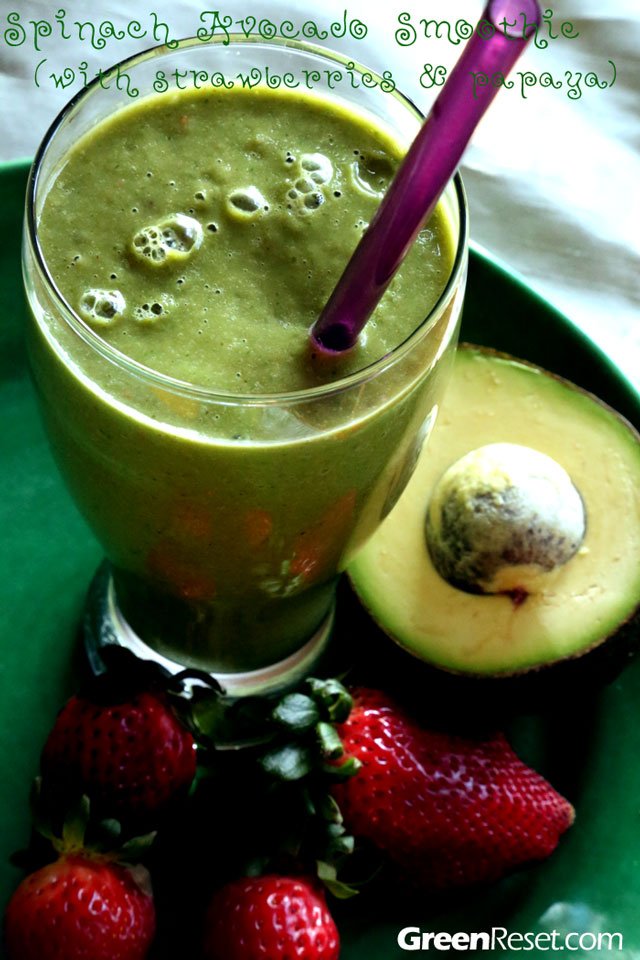
More Banana-Free Smoothie Recipes
So, here are three simple recipes for you with easy-to-find ingredients, which are really delicious: sweet and creamy, just as they should be.
Avocado-Papaya-Strawberry Smoothie
2 handfuls spinach
1 cup strawberries (frozen or fresh)
1 avocado
2 cups water or non dairy milk (such as coconut milk)
Avocado-Apple Smoothie
1 green apple (for example, Granny Smith)
1/2 avocado
1 tablespoon of lemon or lime juice
1/2 – 1 cup water
Pear-Strawberry
2 pears
1 cup whole strawberries
2 cups baby spinach (or other leafy green)
1 celery stalk
1 cup of water
Mango-Strawberry Green Smoothie
1 mango
1 cup whole strawberries
2 cups fresh baby spinach (or other leafy green)
1/2 – 1 cup water
Papaya-Orange Smoothie
2 and 1/2 cups papaya, peeled and deseeded
1 orange, peeled
1 pear, cored
1 celery stalk
2 cups fresh baby spinach (or other leafy green)
1/2 – 1 cup water
Papaya-Apple Smoothie
2 and 1/2 cups papaya, peeled and deseeded
1 apple, cored
2 cups fresh baby spinach (or other leafy green)
1 whole carrot (optional)
Pear-Blueberry
2 pear
1 cup blueberries
2 cups fresh baby spinach (or other leafy green)
¼ avocado
1 cup water
Pear-Apple
2 pear
1 apple
¼ teaspoon cinnamon
2 cups fresh baby spinach (or other leafy green)
½ cup water
Questions? Comments? Suggestions?
If you have a favorite recipe, why not submit it here in the comment section of this smoothie recipes blog for others to enjoy too!
I also welcome any comments, questions and suggestions. Thanks!
Pineapple smoothies are delicious, reminding me of hot summer days on a beach and ice-cold pina colada.
Unfortunately, many pineapple smoothie recipes available both online and in cookbooks call for some form of dairy, either yogurt, milk or cream. Fortunately, it’s easy to substitute, by using non-dairy milk, or simply adding very ripe banana and/or avocado to make the smoothie more creamy. (If you are wondering why, read this post and this post).
So today I have three pineapple recipes for you. One is a simple version of the classic, and two that are green pineapple smoothies. I call them green pina coladas.
Classic Pineapple Smoothie Recipe
1/4 fresh pineapple – peeled, cored and cubed
1 large ripe banana
1 cup non-dairy milk (such as almond, soy, etc.) or water
4 ice cubes (optional)
Green Pineapple Smoothie Recipe
As you already know I put greens practically into each recipe, as I don’t want to miss the opportunity to add more healthy nutrients to my drink. So this one is no different. All ingredients in this smoothie, from the bananas to the pineapple to the coconut to the greens provides a healthy source of vitamins and minerals that come together in a smoothie that is as good for you as it tastes.
Green Piña Colada Pineapple Smoothie
Ingredients
- a 13.5-oz can of coconut milk
- 1 banana
- 4 cups fresh pineapple cut into pieces or frozen pineapple chunks (unsweetened)
- 1/2 bunch of spinach, kale or collard greens, stems removed (4-5 large leaves)
- a few pieces of ice, if you want it chilled
-
-
Instructions
- Blend all ingredients in your blender, beginning with the lowest speed setting and work your way up to the highest setting until the smoothie is creamy. Add more liquid or ice if the mixture is too thick and blend until desired consistency is achieved. Pour into a tall glass, sip and smile!
3.1
https://greenreset.com/pineapple-smoothie/
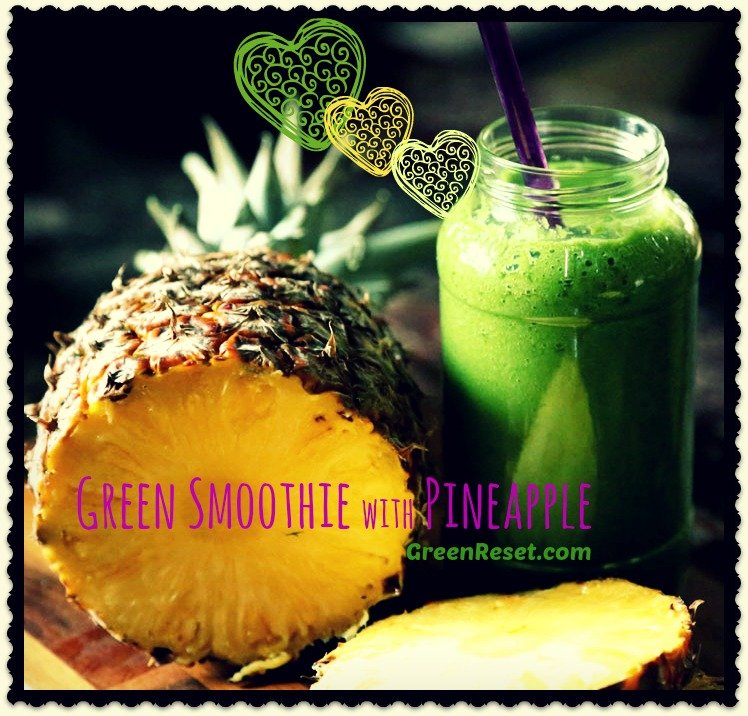
Pineapple-Strawberry Smoothie Recipe That Will Make You Smile!
Ingredients
Instructions
- Blend everything on high. A high power blender is best to blend tough greens, such as kale or collard greens (I use Vitamix).
- Add more water if needed to get things moving around in the blender.
- Pour into a pretty glass, drink, and smile!
3.1
https://greenreset.com/pineapple-smoothie/
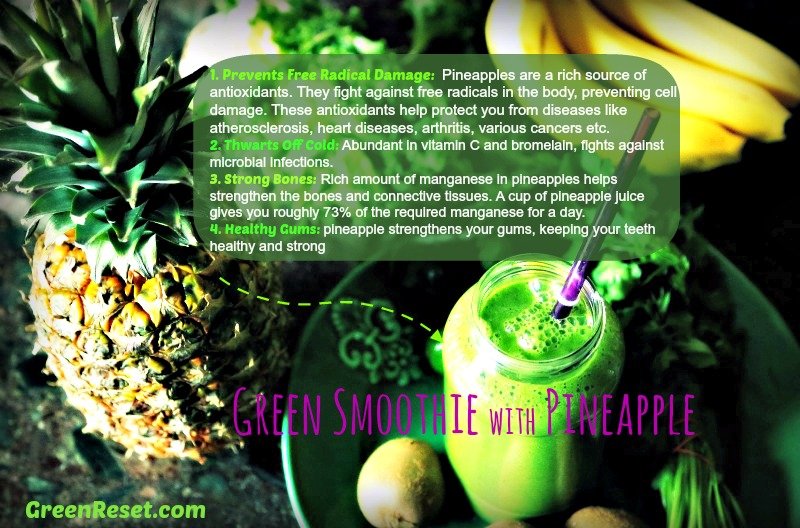
Benefits of Pineapples
Pineapples are delicious (provided that they are ripe), so you don’t need encouragement to eat them, but here are some of the health benefits:
1. Prevents Free Radical Damage: Pineapples are a rich source of antioxidants. They fight against free radicals in the body, preventing cell damage. These antioxidants help protect you from diseases like atherosclerosis, heart diseases, arthritis, various cancers etc.
2. Thwarts Off Cold: Abundant in vitamin C and bromelain, fights against microbial infections.
3. Help Strengthen Bones: Rich amount of manganese present in pineapples helps in strengthening bones and connective tissues. A cup of pineapple juice gives you roughly 73% of the required manganese for a day.
4. Healthy Gums: Eating pineapple strengthens your gums, keeping your teeth healthy and strong.
5. Help Prevent Cancer: The abundance of antioxidants in pineapples helps fight against free radicals, halting the process of cell damage, preventing cancers.
6. Boost Heart Health: Powerful antioxidants keep free radicals away and lower the cholesterol levels, preventing heart diseases.
7. Boost Immunity: Rich content of vitamin C in pineapples boost your immune system by its strong antioxidant effect.
…and more…
How to Fix A Green Smoothie That You Don’t Love
It happens rarely, but it does happen. You made a smoothie that you don’t really care for. Don’t despair! The advantage of smoothies over other types of recipes, such as baking, is that they can be easily fixed.
- “My smoothie is too thick“: Add more liquid. The best liquid for smoothies is water, but any non-dairy milk or fresh juice can be used as well.
- “My smoothie is too watery”: Add more fruits and veggies. Bananas and avocados are great for making thick smoothies that are nice and creamy.
- “My smoothie is too savory“: Add more sweet fruits. Add a packet of stevia, 1-2 tablespoons agave syrup, or other sweetener. A few dates or other dried fruit will also work, but you’ll have to blend it really well.
- “My smoothie is too sweet“: Squeeze some lemon or lime juice into your smoothie. Add more greens and/or celery. Add a tart apple and blend well.
- “My smoothie tastes bland”: Perhaps you added too many ingredients that don’t complement each other, or not enough ingredients that have distinct taste. Whatever the reason, I find that adding spices, such as cinnamon, vanilla, a piece fresh ginger, a piece of lemon (or some lemon juice), or a few fresh mint leaves will add some instant zing to any smoothie that is too bland.
- “My smoothie is too “green” tasting“: Some greens have very distinct flavor. If you added too much strong tasting greens, such as mustard greens or dandelion, and the taste is too strong, you will have to dilute the smoothie by adding more fruits, mild greens and some condiments, such as ginger or lemon.
- “My smoothie has awful color, my child (spouse, etc.) refuses to drink it“. Best way to mask the color is to add some frozen blueberries or cocoa powder to the mix. Another way is to serve it in a non-transparent container with a straw.
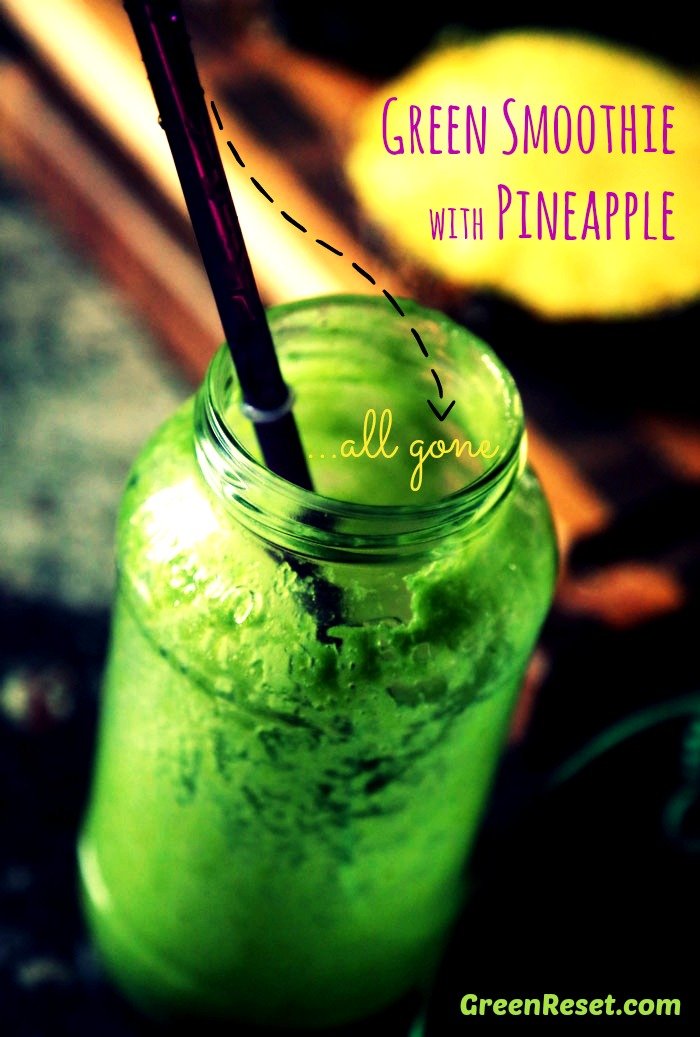
Questions? Comments? Suggestions?
If you have a favorite recipe, why not submit it here in the comment section of this smoothie recipes blog for others to enjoy too!
I also welcome any comments, questions and suggestions. Thanks!





